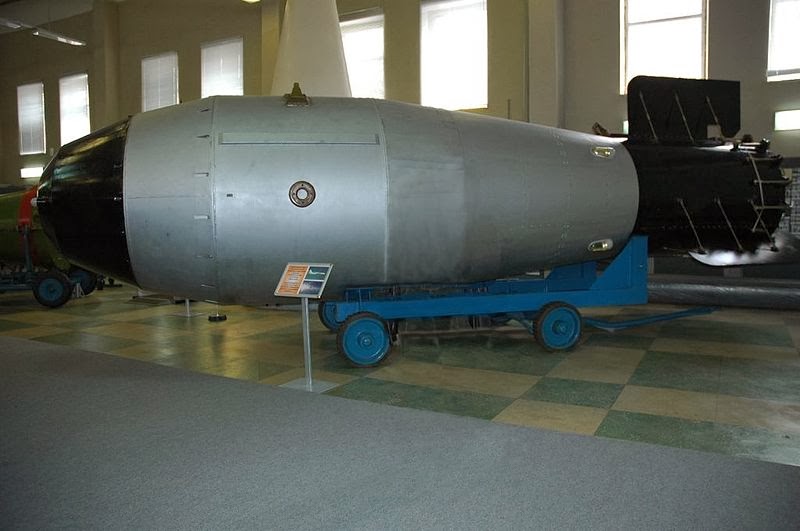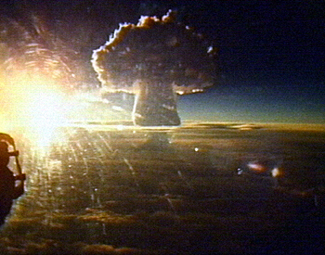
Zone of total destruction of the Tsar Bomba on a map of Paris: red circle = total destruction
On October 30, 1961, the Soviet Union detonated the hydrogen bomb Tsar Bomba over Novaya Zemlya, which still is the largest explosive device ever detonated, nuclear or otherwise.
Technical Challenges
Just to get an idea of the bomb’s power, the Tsar Bomba measured ten times the power of all explosives used during World War II. Still, the bomb was known for the very little amount of fallout, produced during the explosion since about 97% of the entire energy produced resulted from fusion only. The head of construction in the bomb project was Soviet physicist Yulii Borisovich Khariton. Khariton studied under Ernest Rutherford [4] and became head of the Explosion Laboratory at the Institute of Chemical Physics in Cambridge. During the project, Khariton worked with several assistants such as Andrei Sakharov [5], who spoke openly against nuclear weapons after the bomb was detonated and became a dissident. The bomb weighed 27 tons, was eight meters long and measured two meters in diameter. It had a three-stage design and was designed for an explosive force of 100 MT. For the test, half of the explosive force was waived in order to reduce the radioactive contamination by 97 percent by replacing the 238 Uranium of the casing of the third and possibly also the second stage with lead. Uranium in the mantle would have been split by the fast neutrons of the hydrogen stages, which would have at least doubled the explosive force. Lithium deuteride was used as the fusion fuel. In relation to its explosive power, this bomb thus became the “cleanest” nuclear weapon ever used. With uranium sheathing, the explosion of this bomb would have increased the worldwide radioactive load from nuclear weapons tests by about 25 percent. Another technical challenge was the manufacture of the parachute that carried the bomb after it was dropped.

Model of the Tsar Bomba
An Impractical Weapon
Due to its enormous impact, the bomb proved to be quite impractical. It was too heavy and therefore limited the range and speed of carry it. Also, a great amount of its high-yield destructiveness was radiated into space, which was very inefficient. Later research on bombs focused more on efficiency, accuracy and “safety”. Another danger with creating even more powerful bombs was that the explosion went upwards, wherefore radiation would be sent into the atmosphere and affect the country originally launching the bomb. The weight and size of the Tsar Bomba limited the range and speed of the specially modified bomber carrying it. Delivery by an intercontinental ballistic missile would have required a much stronger missile. The Tu-95V plane carrying the bomb during the test was specially modified and flown by Major Andrei Durnovtsev and was accompanied by an observer plane and both were painted white to limit heat damages on the air craft. Since the bomb was attached to a parachute, the two planes had enough time to clear the scene, when the bomb was released. On October 30, 1961 at 11:32 am, the Tsar Bomba detonated over the Mityushikha Bay nuclear testing range.

The mushroom cloud of Tsar Bomba seen from a distance of 161 km (100 mi). The crown of the cloud is 65 km (40 mi) high at the time of the picture.(source: Rosatom State Corporation Communications Department 20-08-2020)
The responsible filming crew stated:
“Outside, there was a sea of light, an ocean of light suddenly bursting out… Once our plane came out of the clouds, in between them, a huge balloon of bright orange color appeared! It was like Jupiter – powerful, and conceited, and confident, slowly and silently crawling up“.
The bomb’s own shock wave prevented that the fireball impacted on the ground and the famous mushroom cloud was about 64 kilometres high. Every building in a range of 55 km was destroyed or at least lost its roof or windows and radio communication was interrupted for more than one hour. Even at a distance of 270 km, people felt a thermal pulse. The amount of the chemical explosive TNT, which would release an energy comparable to the Zar bomb, would have a diameter of 400 metres as a sphere. The shock wave caused by the explosion circled the globe about two and a half times. Although the bomb was detonated at a relatively high altitude, the explosion also excited several types of 5.8 magnitude seismic waves.
To get an idea how nuclear bombs work, you may watch Matthew Bunn’s lecture at Belfer Center, Harvard.
Matthew Bunn, Nuclear 101: How Nuclear Bombs Work Part 1/2 [7]
References and Further Reading:
- [1] The Tsar Bomba (“King of Bombs”)
- [2] The Nuclear Weapon Archive: Soviet Nuclear Weapons
- [3] Moscow’s Biggest Bomb: the 50-Megaton Test of October 1961
- [4] Ernest Rutherford Discovers the Nucleus, SciHi Blog
- [5] Andrei Sakharov and the Soviet Thermonuclear Bomb, SciHi Blog
- [6] Tsar Bomb at Wikidata
- [7] Matthew Bunn, Nuclear 101: How Nuclear Bombs Work Part 1/2 (2013), Belfer Center @ youtube
- [8] Adamsky, Viktor; Yuri Smirnov (Fall 1994). “Moscow’s Biggest Bomb: the 50 Megaton Test of October 1961”. Cold War International History Project Bulletin (4): 3, 19–21.
- [9] Map with Nuclear Weapons Tests, via DBpedia and Wikidata






Pingback: Whewell’s Gazette: Year 2, Vol: #16 | Whewell's Ghost